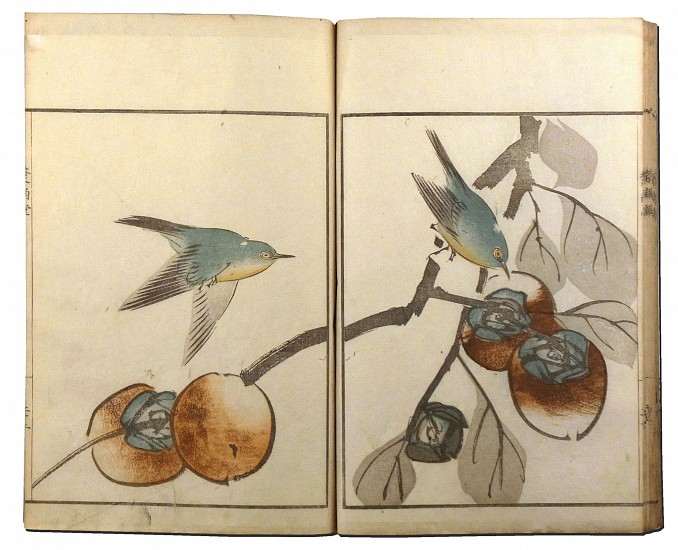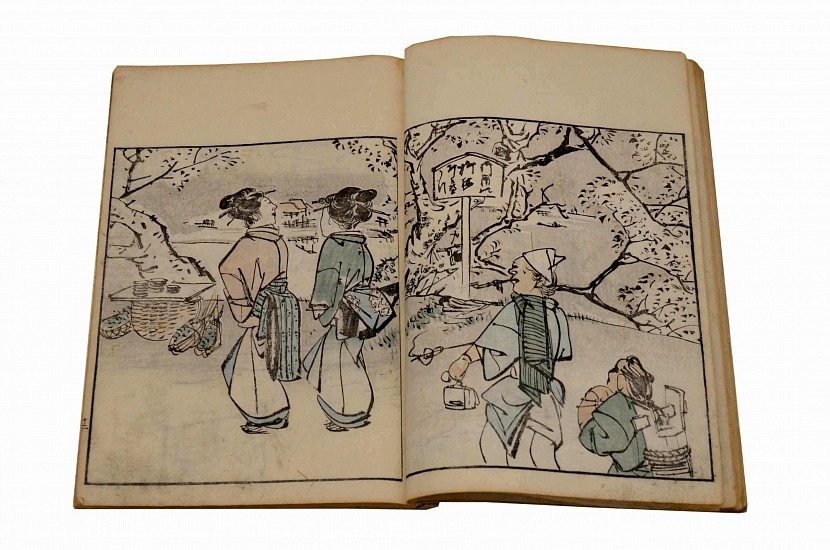Onishi Chinnen
Onishi Chinnen
Sonan Gafu, 1834
2274
10 5/8 x 7 1/8 in. (27 x 18 cm)
A celebrated example by the most accomplished artist of the Shijo School of the Edo Period in Japan. The color woodblock printing is sophisticated, imitating accurately the effects of the watercolor brush. There are amusing devices such as turtles aiming bow-and-arrow at a spread lotus leaf held out by another turtle; depictions of ordinary life of the fishermen coming home with their catch; bold and excellent compositions of flowers and leaves in a remarkable array of colors; a boat party on a lake by the mountains; a bird flying into wisteria; a marvelous great kimono whose wearer sits at her calligraphy. Jack Hillier, an authority on the art of the Japanese book, used the illustration of mountain pines on the cover of his definitive study on the genre Ehon. This is a superb copy, the printing particularly clear. Thread-bound book; 26 illustrated sheets and three sheets of text; woodblock; ink and color on paper. Signed, with red seal. JH 325.
Other known copies are in prominent institutions: The Pulverer Collection in the Freer Gallery of Art, National Institute of Japanese Literature, The British Museum, The Art Institute of Chicago, Museum Volkenkunde (Leiden), University of Pennsylvania Libraries, and the New York Public Library.
Price Upon Request
Onishi Chinnen
Azuma No Teburi (Customs of the Eastern Capital, with subtitle, Scenes of the Great Peace), 1829
3060-BK
11 x 7 5/8 in. (28 x 19.5 cm)
Chinnen's first book:â€â€Azuma no Teburi†(Customs of the Eastern Capital, with subtitle, Scenes of the Great Peace), published in Edo, 1829. This work ranks high among the large group in book history which illustrates the ordinary doings and customs of the day. Jack Hillier (Art of the Japanese Book, 1987, admires it especially: â€Among the twenty-five double page prints are some of the masterpieces of Shijo in color print. Soft transparent pastel-like shades were employed and used broadly over areas sufficiently large to enable one fully to savor individual colors.†Hillier reproduces several of which one can most enjoyably admire the double page of preparing nori (seaweed). The colors are less brilliant than in the â€Sonan Gafu†by the same artist but the effect is not less dashing. Chinnen's books follow across more directly from one page to the next book. Original binding of silver printed over pale blue paper covers. Hillier, pp. 770-775; C.H. Mitchell, The Illustrated Books of the Nanga, Maruyama, Shijo and Other Related Schools of Japan, 1972, pg. 214.
Price Upon Request






